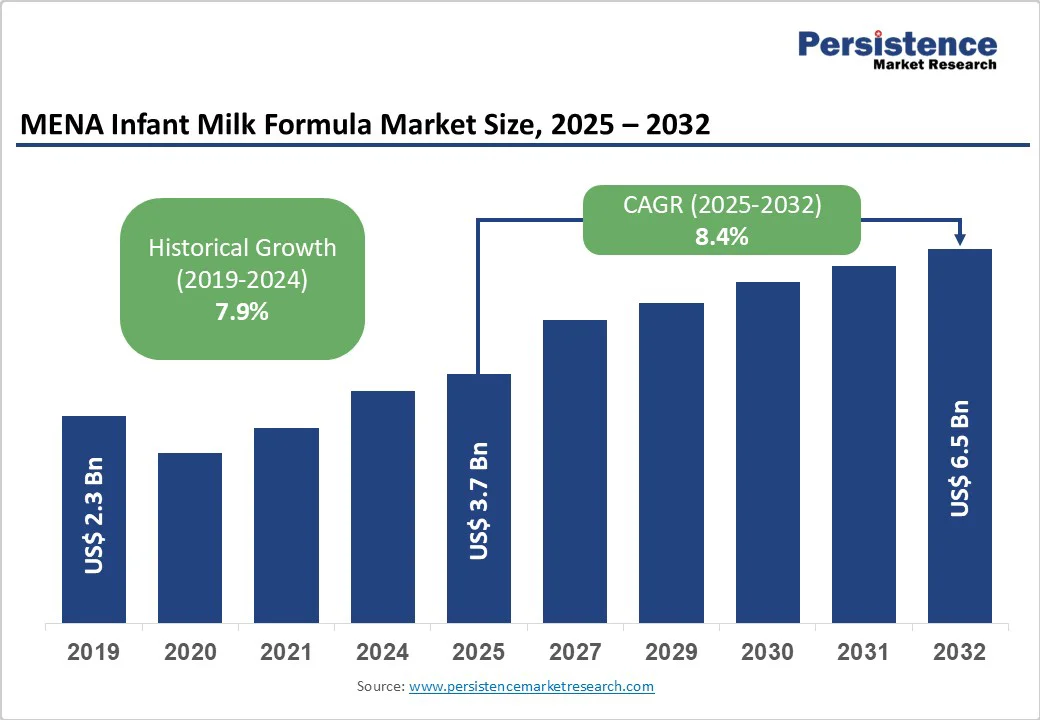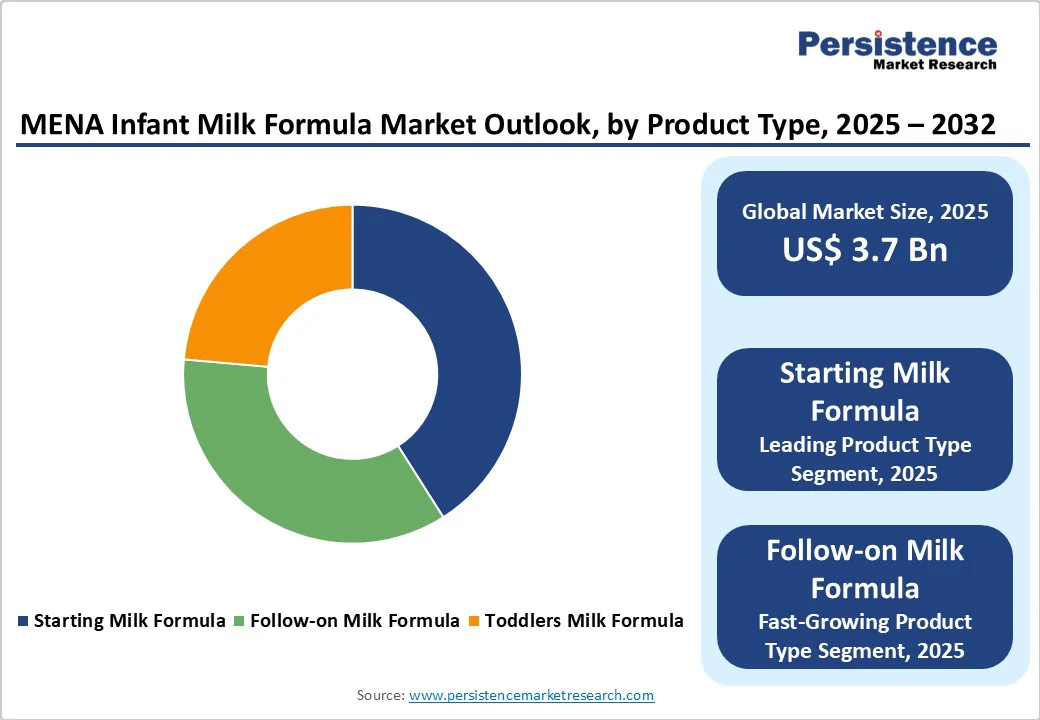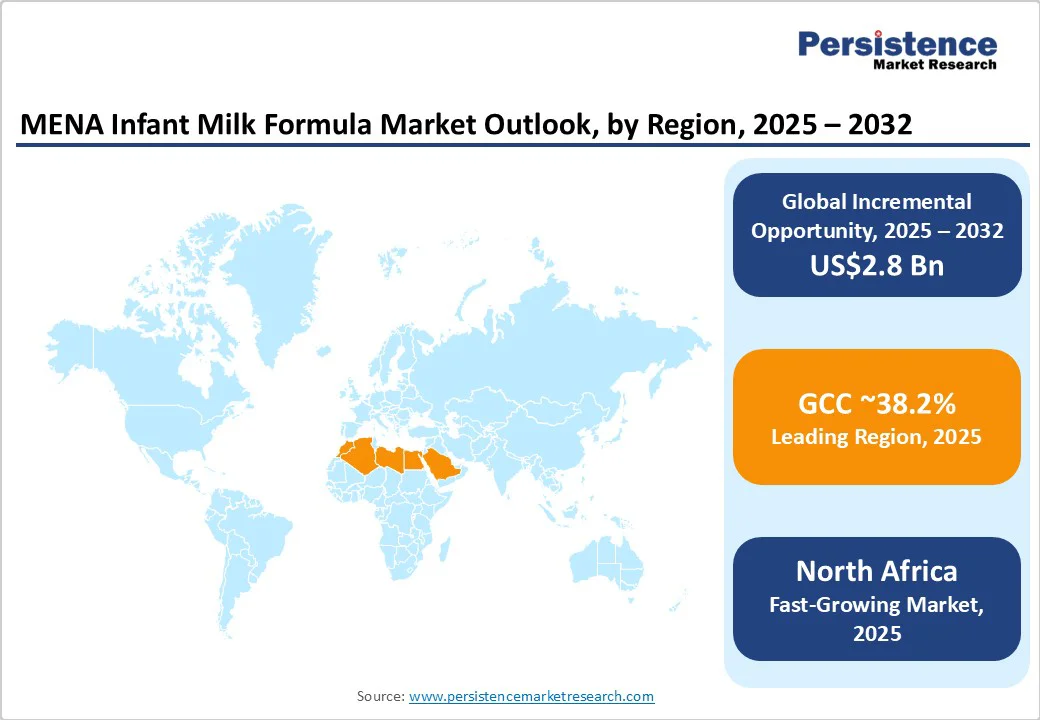ID: PMRREP9001| 167 Pages | 22 Oct 2025 | Format: PDF, Excel, PPT* | Food and Beverages

The MENA infant milk formula market size is likely to be valued at US$3.7 Billion in 2025 and is estimated to reach US$6.5 Billion in 2032, growing at a CAGR of 8.4% during the forecast period 2025-2032, driven by rising awareness of infant nutrition and changing lifestyle patterns. The expanding participation of women in the workforce has also boosted demand.
| Key Insights | Details |
|---|---|
|
MENA Infant Milk Formula Market Size (2025E) |
US$3.7 Billion |
|
Market Value Forecast (2032F) |
US$6.5 Billion |
|
Projected Growth (CAGR 2025 to 2032) |
8.4% |
|
Historical Market Growth (CAGR 2019 to 2024) |
7.9% |

In the MENA region, increasing awareness about infant nutrition and improvements in formula composition are boosting its acceptance as a dependable substitute for breast milk. Modern formulations now include essential nutrients such as DHA, ARA, and HMOs that closely mimic breast milk composition, supporting immune and cognitive development. This is mainly important for mothers who are unable to breastfeed due to medical conditions or insufficient lactation.
Health authorities in countries such as Saudi Arabia and the UAE have also strengthened quality and labeling regulations, improving consumer trust in formula products. Hence, infant formula is now viewed not just as an alternative but as a scientifically balanced and safe nutritional option for infants who require supplementation.
The rise in female workforce participation across MENA, especially in urban centers such as Riyadh, Dubai, and Cairo, has drastically fueled formula use. Working mothers often struggle to maintain exclusive breastfeeding schedules due to limited maternity leave and workplace facilities for pumping or storing milk.
Infant formula provides a practical solution, allowing consistent feeding even when mothers are away from home. Employers in the UAE and Saudi Arabia have started providing flexible childcare support, yet reliance on formula remains common for convenience and flexibility. The availability of ready-to-feed and travel-friendly packaging has further strengthened adoption among career-oriented mothers managing busy routines.
A key restraint for infant milk formula in the MENA region is that some babies experience digestive discomfort, including gas, bloating, and constipation. Unlike breast milk, which naturally adapts to an infant’s digestive system, standard formulas can be difficult to process, leading to feeding difficulties and parental concern.
Even with novel formulas containing partially hydrolyzed proteins or added digestive enzymes, some infants still show intolerance. Pediatricians in Saudi Arabia and the UAE often recommend switching between formula types to manage these issues, but repeated trial-and-error can reduce parental confidence. This digestive sensitivity can slow adoption, mainly among first-time mothers who prioritize ease of digestion and comfort for their babies.
The expense of infant milk formula is another key restraint in MENA markets. Specialty formulas, including hypoallergenic, organic, or fortified variants, carry premium prices, which can be prohibitive for several families. In addition to formula cans, parents must purchase bottles, nipples, sterilizers, and other feeding accessories, further increasing the total cost.
In Lebanon and Egypt, where inflation and currency devaluation have driven up formula prices sharply, many parents struggle to afford consistent supplies, prompting some to seek cheap, potentially unsafe alternatives. This high cost barrier limits the widespread adoption of unique formulas and encourages reliance on breastfeeding or low-cost local products.
A key growth opportunity in the market lies in the inclusion of unique bioactive ingredients that closely mimic the composition of human breast milk. Researchers are increasingly focusing on incorporating compounds such as lactoferrin, nucleotides, and osteopontin, which are known for their roles in improving immunity and supporting gut and bone health.
For instance, brands such as Nestlé and Danone have introduced formulas fortified with lactoferrin to strengthen infants’ natural defense systems. These bioactives not only improve nutritional value but also cater to parents’ rising preference for formulas that replicate breast milk’s natural benefits, thereby supporting healthy development and resilience against infections during early infancy.
The surging awareness of gut health among parents in the MENA region is pushing interest in infant milk formulas fortified with prebiotics and probiotics. These ingredients help build a balanced gut microbiome, which plays an important role in digestion, nutrient absorption, and immunity. Manufacturers are hence launching products with specialized strains of beneficial bacteria such as Bifidobacterium and Lactobacillus to mimic the gut flora of breastfed infants.
For example, Abbott’s Similac range and FrieslandCampina’s Friso Gold have introduced microbiome-supportive variants that appeal to health-conscious families. With pediatricians increasingly recommending gut-friendly nutrition, demand for such functional formulations is anticipated to accelerate across urban centers in the MENA region.
Starting milk formula is projected to account for approximately 41% of the share in 2025, as it is designed for newborns who are either unable to breastfeed or require supplementation in the first six months. Parents, especially in Saudi Arabia, UAE, and Egypt, mainly trust starter formulas for their safety, consistency, and ease of preparation. Brands such as Nestlé NAN 1 and Abbott Similac 1 are marketed heavily as ‘complete first nutrition.
Follow-on milk formula is gaining traction because it caters to infants aged 6 to 12 months who are gradually transitioning to solid foods but still require supplemental nutrition. These formulas are enriched with high protein, iron, and micronutrients to support rapid growth, cognitive development, and immunity. In MENA, rising dual-income households and working mothers have spurred demand for follow-on formulas, as they deliver convenience while maintaining balanced nutrition.
The 0 to 6 months segment is anticipated to hold a share of nearly 46.8% in 2025, as this is the period when exclusive nutrition is important for growth and development. Breast milk provides essential antibodies and nutrients during this stage, but when breastfeeding is not possible, formula becomes the only complete alternative. Formulas for this age group are specifically designed to replicate the composition of breast milk, including proteins, fats, vitamins, and minerals.
The 24 to 36 months segment will likely witness steady growth because toddlers are transitioning to solid foods but still require supplemental nutrition to meet their rapid growth and developmental requirements. Formulas in this segment often provide high protein and micronutrient content, such as iron, calcium, and vitamins, to support bone, muscle, and cognitive development.
Supermarkets/hypermarkets are predicted to capture a share of about 32.5% in 2025 as they provide convenience, variety, and credibility for parents. Large chains such as Carrefour, Lulu, and Spinneys provide a wide range of international and local brands under one roof, allowing parents to compare products and prices easily. These stores also ensure product authenticity, which is essential in markets where counterfeit formula is a concern.
Online retail is speculated to see considerable growth owing to convenience, home delivery, and access to a wide range of brands, including hard-to-find or imported formulas. E-commerce platforms such as Amazon UAE, Noon, and Mumzworld allow parents to subscribe to recurring deliveries, reducing the risk of stockouts. Online channels also provide detailed product information, reviews, and comparison tools, which influence purchase decisions.

In 2025, GCC is expected to account for approximately 38.2% of the share. Saudi Arabia’s Saudi Food and Drug Authority (SFDA) has made it mandatory that all Breast-Milk Substitute (BMS) products have no added sugars per its national specifications. They are actively inspecting imports/manufacturers for compliance. The Saudi Ministry of Health fined a company nearly SAR 250,000 in 2023 for distributing promotional materials for BMS inside hospitals, which is a breach of the country’s BMS marketing code.
The GCC market is still dominated by global brands such as Nestlé, Danone, and Abbott, but local players are becoming more visible. Almarai, a Saudi dairy giant, continues its joint venture with Mead Johnson to produce and distribute infant nutrition products customized for regional demands. This local production base helps meet halal and labeling standards while improving supply stability across the GCC. Companies with regional manufacturing hubs also benefit from fast distribution and better control over pricing amid strict import checks.
North Africa’s market is currently undergoing major changes propelled by local production initiatives and affordability issues. Egypt has taken the lead in developing large-scale domestic formula manufacturing to reduce reliance on imports. The government is investing heavily in new plants, including a state-owned factory expected to supply half of Egypt’s demands, delivering formula at nearly 40 to 50% lower prices than imported brands. Lacto Misr, a government-backed company, is spearheading these efforts and aims to meet national demand while maintaining international quality standards.
This move is part of a broad strategy to improve food security and make formula accessible to low-income families. However, North Africa faces persistent price inflation, especially in Morocco, where formula has become increasingly expensive for middle- and low-income households. Reports from Morocco indicate that prices have risen by more than 14% in recent years, prompting some families to switch to unsafe alternatives such as cow’s milk.
In the Levant, the market is influenced by economic crises, supply shortages, and import dependency. In Syria, years of conflict and border restrictions have severely disrupted supply chains, leading to frequent shortages and sharp price fluctuations. Reports from 2024 showed that the price of a single can of formula such as Nestlé’s NAN1, reached as high as 80,000 Syrian pounds during scarcity periods.
In Lebanon, the government has removed subsidies on infant formula in early 2023 after discovering large-scale smuggling of subsidized milk to neighboring countries such as Syria. This decision caused formula prices to more than double within months, making them unaffordable for most families. In Jordan, the situation is comparatively stable, though rising import costs and inflation are limiting product variety and pushing families toward local or regional alternatives.

The MENA infant milk formula market is dominated by key international players such as Nestlé, Danone, Abbott, and Reckitt (Mead Johnson). These companies control most of the premium and specialty formula segments through their established brands, including NAN, Aptamil, Similac, and Enfamil. They are investing heavily in local manufacturing and distribution partnerships to improve supply stability and meet halal certification standards. For instance, Danone has strengthened its Middle East operations by extending its nutrition portfolio with unique formulas containing HMOs and probiotics to match evolving consumer health preferences.
The MENA infant milk formula market is projected to reach US$3.7 Billion in 2025.
Rising awareness of infant nutrition and working mothers’ demand for convenient feeding solutions are the key market drivers.
The MENA infant milk formula market is poised to witness a CAGR of 8.4% from 2025 to 2032.
Expansion of premium formulas and local production to reduce import dependence are the key market opportunities.
Nutridar Company Plc., Abbott Laboratories, and Ausnutria Hyproca B.V. are a few key market players.
| Report Attribute | Details |
|---|---|
|
Historical Data/Actuals |
2019 - 2024 |
|
Forecast Period |
2025 - 2032 |
|
Market Analysis |
Value: US$ Bn |
|
Geographical Coverage |
|
|
Segmental Coverage |
|
|
Competitive Analysis |
|
|
Report Highlights |
|
By Product Type
By Age Group
By Distribution Channel
By Region
Delivery Timelines
For more information on this report and its delivery timelines please get in touch with our sales team.
About Author